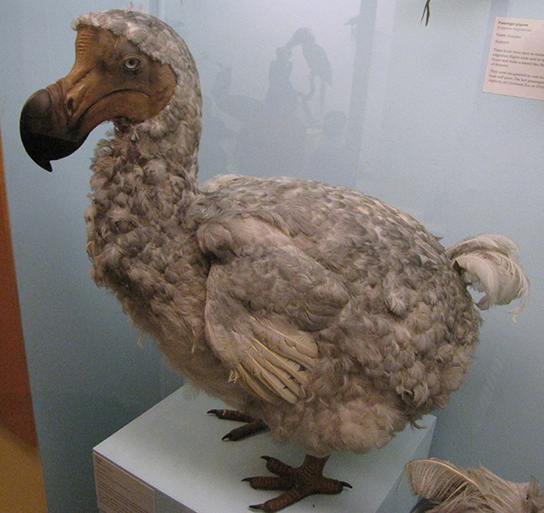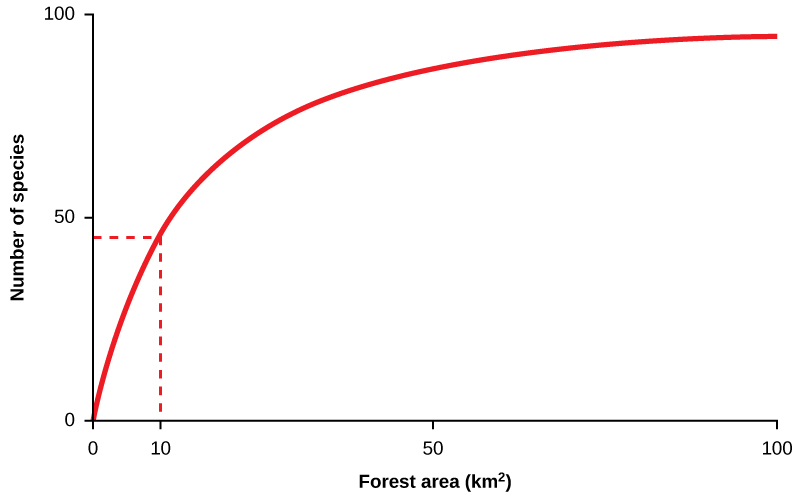12.2: History of Extinction
- Page ID
- 70847
Speciation and Extinction
The number of species on the planet, or in any geographical area, is the result of an equilibrium of two evolutionary processes that are ongoing: speciation and extinction. Speciation occurs when new species evolve, and extinction is the global loss of a species. When speciation rates begin to outstrip extinction rates, the number of species will increase; likewise, the number of species will decrease when extinction rates begin to overtake speciation rates. Throughout Earth’s history, these two processes have fluctuated—sometimes leading to dramatic changes in the number of species on Earth as reflected in the fossil record (Table \(\PageIndex{a}\)).
Mass Extinctions
Paleontologists have identified five events in geological history of sudden and dramatic losses in biodiversity, with more than half of all extant species disappearing from the fossil record. Extant species are those that are surviving (not extinct) at a point in time. These five events are called mass extinctions. There are many lesser, yet still dramatic, extinction events, but the five mass extinctions have attracted the most research. An argument can be made that the five mass extinctions are only the five most extreme events in a continuous series of large extinction events that have occurred since 542 million years ago.
The fossil record of the mass extinctions was the basis for defining periods of geological history, so they typically occur at the transition point between geological periods. The transition in fossils from one period to another reflects the dramatic loss of species and the gradual origin of new species. These transitions can be seen in the rock layers. Table \(\PageIndex{a}\) provides the names and dates of the five mass extinctions.
In most cases, the hypothesized causes are still controversial; however, the causes of the most recent event, the end-Cretaceous extinction, are best understood (table \(\PageIndex{a}\)). It was during this extinction event that the dinosaurs, the dominant vertebrate group for millions of years, disappeared from the planet (with the exception of a theropod clade that gave rise to birds). Indeed, every land animal that weighed more then 25 kg (55 lbs) became extinct. The cause of this extinction is now understood to be the result of a cataclysmic impact of a large meteorite, or asteroid, off the coast of what is now the Yucatán Peninsula. Biodiversity recovery times after mass extinctions vary, but have been up to 30 million years.
| Geological Period | Mass Extinction Name | Time (millions of years ago) | Loss in Biodiversity | Hypothesized Cause(s) |
|---|---|---|---|---|
| Ordovician–Silurian | end-Ordovician O–S | 450–440 | 85% of marine species | Global cooling and then warming, gamma-ray burst from supernova removed ozone layer |
| Late Devonian | end-Devonian | 375–360 | 79-87% of all species | Unknown |
| Permian–Triassic | end-Permian | 251 | 96% of marine species and 70% of terrestrial (land) species | Volcanic activity, decrease on dissolved oxygen in the oceans |
| Triassic–Jurassic | end-Triassic | 205 | 76% of all species | Climate change, asteroid impact, volcanic eruptions |
| Cretaceous–Paleogene | end-Cretaceous K–Pg (K–T) | 65.5 | 50% of animals and plants | Asteroid impact |
The Pleistocene Extinction is one of the lesser extinctions, and a recent one. It is well known that the North American, and to some degree Eurasian megafauna, or large animals, disappeared toward the end of the last glaciation (cooling) period. The extinction appears to have happened in a relatively restricted time period of 10,000–12,000 years ago. In North America, the losses were quite dramatic and included the woolly mammoths (last dated about 4,000 years ago in an isolated population), mastodon, giant beavers, giant ground sloths, saber-toothed cats, and the North American camel, just to name a few. The possibility that the rapid extinction of these large animals was caused by overhunting, a type of overexploitation, was first suggested in the 1900s. Research into this hypothesis continues today. It seems likely that overhunting caused many pre-written history extinctions in many regions of the world.
The Sixth Mass Extinction
The sixth, or Holocene, mass extinction appears to have begun earlier than previously believed and has mostly to do with the activities of Homo sapiens. Since the beginning of the Holocene period, there are numerous recent extinctions of individual species that are recorded in human writings. Most of these are coincident with the expansion of the European colonies since the 1500s.
One of the earlier and popularly known examples is the dodo bird. The dodo bird lived in the forests of Mauritius, an island in the Indian Ocean. The dodo bird became extinct around 1662 (figure \(\PageIndex{b}\)). It was hunted for its meat by sailors and was easy prey because the dodo, which did not evolve with humans, would approach people without fear. Introduced pigs, rats, and dogs brought to the island by European ships also killed dodo young and eggs.

Figure \(\PageIndex{b}\): The dodo bird was hunted to extinction around 1662. (credit: Ed Uthman, taken in Natural History Museum, London, England)
Steller's sea cow became extinct in 1768; it was related to the manatee and probably once lived along the northwest coast of North America. Steller's sea cow was first discovered by Europeans in 1741 and was hunted for meat and oil. The last sea cow was killed in 1768. That amounts to 27 years between the sea cow’s first contact with Europeans and extinction of the species.
In 1914, the last living passenger pigeon died in a zoo in Cincinnati, Ohio. This species had once darkened the skies of North America during its migrations, but it was hunted and suffered from habitat loss through the clearing of forests for farmland. In 1918, the last living Carolina parakeet died in captivity. This species was once common in the eastern United States, but it suffered from habitat loss. The species was also hunted because it ate orchard fruit when its native foods were destroyed to make way for farmland. The Japanese sea lion, which inhabited a broad area around Japan and the coast of Korea, became extinct in the 1950s due to fishermen. The Caribbean monk seal was distributed throughout the Caribbean Sea but was driven to extinction via hunting by 1952.
As described in the next section, the current high rates of extinction will cause a large and rapid decline in the biodiversity of the planet. According to a 2019 United Nations report, 1 million species are at risk of extinction. Considering there are estimated to be 8-11 million species total (see The Number of Species on Earth), that means up to 12.5% of species could go extinct, and many of them within our lifetimes.
Estimates of Present-Time Extinction Rates
The background extinction rate is estimated to be about 1 extinction per million species each year (E/MSY). For example, if there are 8-11 million species in existence, then we would expect 8-11 of those species to become extinct in a year.
Estimates of extinction rates are hampered by the fact that most extinctions are probably happening without observation. One contemporary extinction-rate estimate uses the extinctions in the written record since the year 1500. For birds alone, this method yields an estimate of 26 E/MSY, almost three times the background rate. However, this value may be underestimated for three reasons. First, many existing species would not have been described until much later in the time period and so their loss would have gone unnoticed. Second, we know the number is higher than the written record suggests because now extinct species are being described from skeletal remains that were never mentioned in written history. And third, some species are probably already extinct even though conservationists are reluctant to name them as such. Taking these factors into account raises the estimated extinction rate to nearer 100 E/MSY. The predicted rate by the end of the century is 1500 E/MSY.
A second approach to estimating present-time extinction rates is to correlate species loss with habitat loss, and it is based on measuring forest-area loss and understanding species–area relationships. The species-area relationship is the rate at which new species are seen when the area surveyed is increased (figure \(\PageIndex{c}\)). Likewise, if the habitat area is reduced, the number of species seen will also decline. This kind of relationship is also seen in the relationship between an island’s area and the number of species present on the island: as one increases, so does the other, though not in a straight line. Estimates of extinction rates based on habitat loss and species–area relationships have suggested that with about 90 percent of habitat loss an expected 50 percent of species would become extinct. Species–area estimates have led to estimates of present-day species extinction rates of about 1000 E/MSY and higher.

Figure \(\PageIndex{c}\): A typical species-area curve shows the cumulative number of species found as more and more area is sampled. The curve has also been interpreted to show the effect on species numbers of destroying habitat; a reduction in habitat of 90 percent from 100 km2 to 10 km2 reduces the number of species supported by about 50 percent.
Many extinctions will affect species that biologists have not yet discovered. Most of these “invisible” species that will become extinct currently live in tropical rainforests (figure \(\PageIndex{d}\)). These rainforests are the most diverse ecosystems on the planet and are being destroyed rapidly by deforestation to provide timber and space for agriculture.

Figure \(\PageIndex{d}\): This tropical lowland rainforest in Madagascar is an example of a high biodiversity habitat. This particular location is protected within a national forest, yet only 10 percent of the original coastal lowland forest remains, and research suggests half the original biodiversity has been lost. (credit: Frank Vassen)
Extirpation
The elimination of species at a local level–known as extirpation – also poses threats to the integrity and sustainability of ecosystems. Widespread extirpation can obviously lead to extinction, but absence of species, even at a local scale, can affect ecosystem function. For example, by the mid-1920s wolves had been extirpated from Yellowstone National Park, although they continued to thrive elsewhere. When wolves were reintroduced to the park in the mid-1990s, they regulated elk populations, benefiting the vegetation and plant communities (see Ecosystem Restoration). What mattered for ecosystem function in Yellowstone was whether wolves were present there, not just whether the species survived somewhere.
References
UN Report: Nature’s Dangerous Decline ‘Unprecedented’; Species Extinction Rates ‘Accelerating’. 2019. United Nations. Accessed 2020-08-01.
Attributions
Modified by Melissa Ha from the following sources:
- The Biodiversity Crisis from General Biology by OpenStax (licensed under CC-BY)
- Preserving Biodiversity and Importance of Biodiversity from Environmental Biology by Matthew R. Fisher (licensed under CC-BY)
- Biodiversity, Species Loss, and Ecosystem Function by Tom Theis and Jonathan Tomkin, Editors. Download for free at CNX. (licensed under CC-BY)


